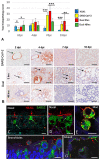Prior Influenza Infection Mitigates SARS-CoV-2 Disease in Syrian Hamsters
- PMID: 38400021
- PMCID: PMC10891789
- DOI: 10.3390/v16020246
Prior Influenza Infection Mitigates SARS-CoV-2 Disease in Syrian Hamsters
Abstract
Seasonal infection rates of individual viruses are influenced by synergistic or inhibitory interactions between coincident viruses. Endemic patterns of SARS-CoV-2 and influenza infection overlap seasonally in the Northern hemisphere and may be similarly influenced. We explored the immunopathologic basis of SARS-CoV-2 and influenza A (H1N1pdm09) interactions in Syrian hamsters. H1N1 given 48 h prior to SARS-CoV-2 profoundly mitigated weight loss and lung pathology compared to SARS-CoV-2 infection alone. This was accompanied by the normalization of granulocyte dynamics and accelerated antigen-presenting populations in bronchoalveolar lavage and blood. Using nasal transcriptomics, we identified a rapid upregulation of innate and antiviral pathways induced by H1N1 by the time of SARS-CoV-2 inoculation in 48 h dual-infected animals. The animals that were infected with both viruses also showed a notable and temporary downregulation of mitochondrial and viral replication pathways. Quantitative RT-PCR confirmed a decrease in the SARS-CoV-2 viral load and lower cytokine levels in the lungs of animals infected with both viruses throughout the course of the disease. Our data confirm that H1N1 infection induces rapid and transient gene expression that is associated with the mitigation of SARS-CoV-2 pulmonary disease. These protective responses are likely to begin in the upper respiratory tract shortly after infection. On a population level, interaction between these two viruses may influence their relative seasonal infection rates.
Keywords: SARS-CoV-2; hamster; influenza; interference; transcriptomics.
Conflict of interest statement
The authors declare no conflicts of interest.
Figures







Similar articles
-
Coinfection by Severe Acute Respiratory Syndrome Coronavirus 2 and Influenza A(H1N1)pdm09 Virus Enhances the Severity of Pneumonia in Golden Syrian Hamsters.Clin Infect Dis. 2021 Jun 15;72(12):e978-e992. doi: 10.1093/cid/ciaa1747. Clin Infect Dis. 2021. PMID: 33216851 Free PMC article.
-
Severe acute respiratory syndrome coronavirus 2 and influenza A virus co-infection alters viral tropism and haematological composition in Syrian hamsters.Transbound Emerg Dis. 2022 Sep;69(5):e3297-e3304. doi: 10.1111/tbed.14601. Epub 2022 Jun 6. Transbound Emerg Dis. 2022. PMID: 35648595 Free PMC article.
-
Human Nasal and Lung Tissues Infected Ex Vivo with SARS-CoV-2 Provide Insights into Differential Tissue-Specific and Virus-Specific Innate Immune Responses in the Upper and Lower Respiratory Tract.J Virol. 2021 Jun 24;95(14):e0013021. doi: 10.1128/JVI.00130-21. Epub 2021 Jun 24. J Virol. 2021. PMID: 33893170 Free PMC article.
-
Hamsters as a Model of Severe Acute Respiratory Syndrome Coronavirus-2.Comp Med. 2021 Oct 1;71(5):398-410. doi: 10.30802/AALAS-CM-21-000036. Epub 2021 Sep 29. Comp Med. 2021. PMID: 34588095 Free PMC article. Review.
-
Lung Histopathology in Coronavirus Disease 2019 as Compared With Severe Acute Respiratory Sydrome and H1N1 Influenza: A Systematic Review.Chest. 2021 Jan;159(1):73-84. doi: 10.1016/j.chest.2020.09.259. Epub 2020 Oct 7. Chest. 2021. PMID: 33038391 Free PMC article.
Cited by
-
Sequential Infection with Influenza A Virus Followed by Severe Acute Respiratory Syndrome Coronavirus 2 (SARS-CoV-2) Leads to More Severe Disease and Encephalitis in a Mouse Model of COVID-19.Viruses. 2024 May 28;16(6):863. doi: 10.3390/v16060863. Viruses. 2024. PMID: 38932155 Free PMC article.
-
High burden of viruses and bacterial pathobionts drives heightened nasal innate immunity in children.J Exp Med. 2024 Sep 2;221(9):e20230911. doi: 10.1084/jem.20230911. Epub 2024 Jul 1. J Exp Med. 2024. PMID: 38949638 Free PMC article.
-
Respiratory long COVID in aged hamsters features impaired lung function post-exercise with bronchiolization and fibrosis.Nat Commun. 2025 Feb 28;16(1):2080. doi: 10.1038/s41467-025-57267-x. Nat Commun. 2025. PMID: 40021627 Free PMC article.
-
Respiratory viral coinfections: interactions, mechanisms and clinical implications.Nat Rev Microbiol. 2025 Aug 20. doi: 10.1038/s41579-025-01225-3. Online ahead of print. Nat Rev Microbiol. 2025. PMID: 40835977 Review.
References
-
- Musuuza J.S., Watson L., Parmasad V., Putman-Buehler N., Christensen L., Safdar N. Prevalence and outcomes of coinfection and superinfection with SARS-CoV-2 and other pathogens: A systematic review and meta-analysis. PLoS ONE. 2021;16:e0251170. doi: 10.1371/journal.pone.0251170. - DOI - PMC - PubMed
-
- Stowe J., Tessier E., Zhao H., Guy R., Muller-Pebody B., Zambon M., Andrews N., Ramsay M., Lopez Bernal J. Interactions between SARS-CoV-2 and influenza, and the impact of coinfection on disease severity: A test-negative design. Int. J. Epidemiol. 2021;50:1124–1133. doi: 10.1093/ije/dyab081. - DOI - PMC - PubMed
MeSH terms
Grants and funding
LinkOut - more resources
Full Text Sources
Medical
Molecular Biology Databases
Miscellaneous

